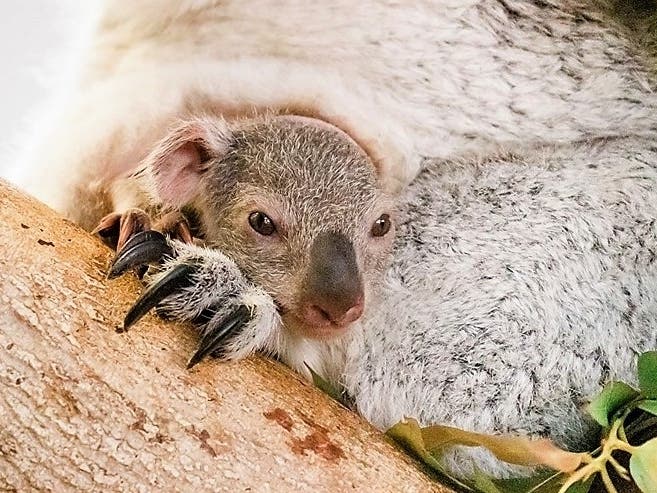Community Corner
Koala Joey Takes 1st Peek At World From Safety Of Mom's Pouch
Animal care professionals at ZooTampa were excited to see Heathcliff and Ceduna's joey finally stick its head out Ceduna's pouch.
TAMPA, FL -- Animal care professionals at ZooTampa were excited to see Heathcliff and Ceduna's joey finally stick its head out Ceduna's pouch a few days ago.
This was the first time the little joey (koala baby) has allowed zoo workers to see its entire face, although they've caught teasing glimpses of parts of its head and a timid paw reaching up through the pouch.
The joey, whose sex has not been determined, is the first koala baby born at the zoo in its 62-year history.
Find out what's happening in Seminole Heightswith free, real-time updates from Patch.
Once an embryo the size of a jellybean, the joey has made the journey to Ceduna’s pouch, where it will finish its final stages of pouch life development under the watchful eyes of Cenduna and Heathcliff.
Koalas are mammals and are sometimes referred to as bears, even though they are not. Rather, koalas are marsupials that differ from other mammals because their newborns develop inside mothers’ pouches instead of a womb. Initially, a joey is blind and earless and relies on natural instincts and strong senses of touch and smell to find its way from the birth canal to its mother’s pouch.
Find out what's happening in Seminole Heightswith free, real-time updates from Patch.
Ceduna, who arrived at the zoo in 2015, and Heathcliff, who arrived in 2014, are part of the zoo’s effort to conserve the koala through the Species Survival Plan of the Association of Zoos and Aquariums.
After the pair’s successful mating, veterinary and animal care teams are celebrating the recent birth and new addition to the Australia habitat, Wallaroo Station.
Throughout the pregnancy and joey’s development, Ceduna’s care has included thermography scans that inform her care team of changes in her muscular, skeletal and nervous systems and ensure optimal health.
“We do routine check-ups with Ceduna to build strong bonds with her and ensure the highest quality of care,” said Lauren Smith, veterinarian at ZooTampa. “The animal care team continues to monitor Ceduna and her baby closely as the joey’s exciting development continues.”
One of Australia’s most iconic animals, koalas live primarily in forests and woodlands dominated by eucalyptus plants. Though poisonous to other species, specialized bacteria in a koala’s digestive tract enables it to break down the plant’s toxins and rely heavily on eucalyptus for its food.
Mature koalas spend up to five hours feeding on the plant leaves every day. For this solitary species, the rest of the day is spent sleeping. Up to 95 percent of a koala’s life is spent by itself.
In large part because of Australia’s national pride in the species, koalas have survived the threat of extinction from habitat loss and hunting.
“We are proud to support conservation initiatives both at home and beyond,” said Dr. Larry Killmar, senior vice president and chief zoological officer at ZooTampa. “Our partnership with the Australian government allows us to support the goals and objectives of the Koala Species Survival Plan.”
Once it fully emerges, zoo guests can catch a glimpse of the joey clings to Ceduna's back or belly until it reaches 1 year old and can begin climbing trees on its own.
To get an even closer look at this unique species, guests can add a Koala Photo Encounter presented by the Yob Family Foundation to their visit to meet the joey’s dad, Heathcliff, and receive a photo.
The zoo is located at 1101 W. Sligh Ave. in Tampa, and is open seven days a week from 9:30 a.m. to 5 p.m. with extended hours for select events. Parking is free.
Get more local news delivered straight to your inbox. Sign up for free Patch newsletters and alerts.
